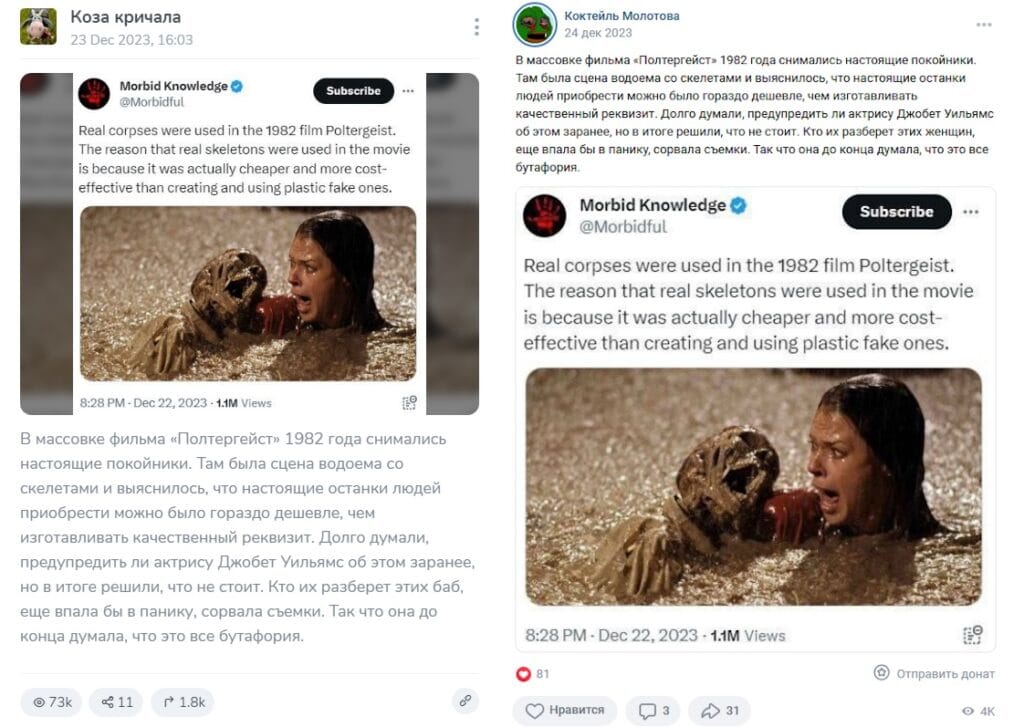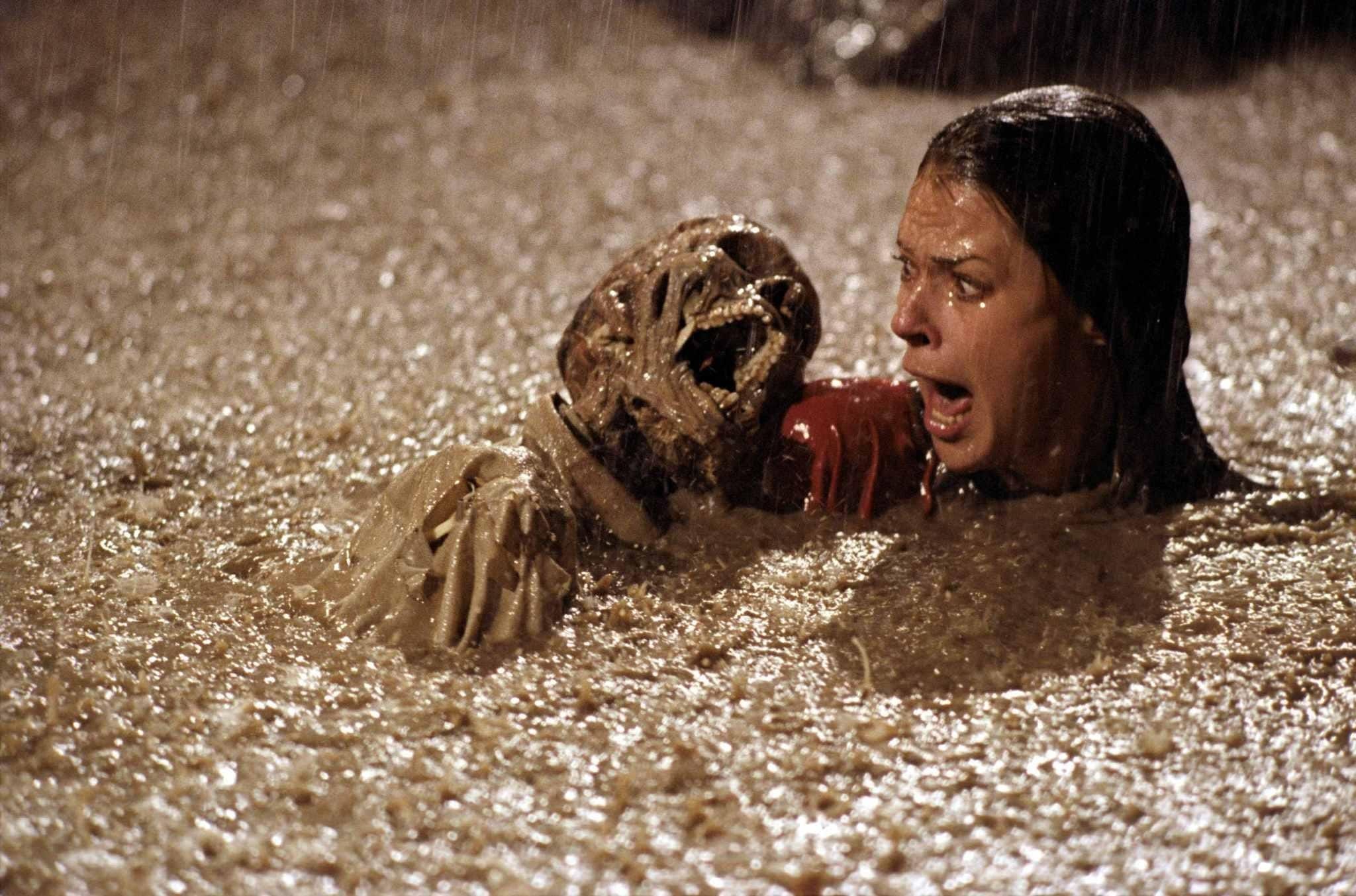There are posts and articles on the Internet claiming that the authors of the 1982 horror film used real human remains on the set. It was reportedly cheaper for producers to source real bodies than to make props. We checked whether such publications correspond to reality.
In December 2023, the Telegram channel "KB +18” (378,000 views at the time of writing this analysis) summarized the viral story as follows: “The extras in the 1982 film Poltergeist featured real dead people. There was a scene of a pond with skeletons, and it turned out that real human remains could be purchased much cheaper than making high-quality props. We thought for a long time whether to warn actress JoBeth Williams about this in advance, but in the end we decided that it was not worth it. Whoever figured them out, these women, would have gone into a panic and disrupted the filming. So until the end she thought it was all a sham.” Similar posts were published at the same time in the channels “The goat screamed"(73,000 views), "r/repeater" (70,000), "Knife" (19,000) and "Saw tin 18+"(19,000), as well as in public pages on VKontakte, including Dankest (21,000 views) and others (examples here, here And here).
Often in such posts, as an illustration, a screenshot of an English-language tweet that has received more than 1 million views is given, with the same story and a frame from the corresponding scene of the film. In the comments, some users were surprised how the actors didn't pay attention to the cadaverous smell, and wondered who allowed the creators of the picture use half-rotten remains. In some articles lead the opinion that such an attitude towards the bodies of the deceased could cause a curse, because of which misfortunes subsequently haunted the members of the film crew. You can also find version, that for the authenticity of the story about evil spirits, Steven Spielberg, who was one of the creators of the film, insisted on using real remains.

"Poltergeist» directed by Tobe Hooper came out on screens in 1982, one of the screenwriters and producers of the project spoke Steven Spielberg. By plot A family whose house was built on the site of an old cemetery is haunted by evil spirits. The film quickly acquired the status of a cult horror film: the film became one of the highest-grossing films that time, was nominated for an Oscar in three categories and received two sequels and a remake of the same name. Due to the deaths of several actors and actresses of the franchise, including the stars of the original Heather O'Rourke (died due to misdiagnosis of intestinal stenosis) and her on-screen sister Dominic Dunn (strangled by her boyfriend), "Poltergeist" became infamous as a cursed film series.
According to a popular theory, this curse, like in the film itself, is explained by the disrespectful attitude of the film's creators towards the deceased. So, in the story, developers erected a building on top of the graves, and the filmmakers reportedly used real dead people. In "Poltergeist" there is scene, when actress JoBeth Williams' character falls into a swimming pool pit during a rainstorm and the dead burst out of the ground. Footage from the filming of this particular fragment is featured in most viral publications.
Williams herself has repeatedly stated over the years that real human skeletons were used during the filming of the episode. “You have to understand that this scene probably took four or five days to film. So during this time I was constantly in the mud and slush with skeletons surrounding me and screaming. In my innocence and naivety, I believed that these were not real skeletons. I assumed that they were fake and made of plastic or rubber. I, like the rest of the film crew, learned that they used real skeletons because making fake ones out of rubber is too expensive. And I think everyone felt creepy just thinking about it,” told actress in 2008 in the program TV Land: Myths and Legends.
In a podcast episode Hot Flashes & Cool Topics, released in 2023, Williams repeated almost the same thing: “I thought that the skeletons were props and that they were made by the props department. But a few years later I found out that these were actually real skeletons, and I thought: if I had known that, I’m not sure if I would have been able to get involved in this story.” That is, one of the main stars of the film generally confirms the information from the distributed posts.

However, he adheres to another version Craig Reardon is a special effects artist who worked on Poltergeist and many other famous films. In 2017 on the thematic site Bloody Good Horror it turned out interview in which Reardon was asked about the curse of the film and the alleged connection of the misfortunes that befell the actors with real skeletons.
“Now I will very simply describe what these “real skeletons” were. The skeletons I ordered in 1981 were featured in the catalog of a biomaterial supply company. They were assembled for classroom display and came with a metal stand and vinyl cover. I ordered 12 or 13 of them (in the 1980s a couple of screenwriters filed lawsuit against the studio, as part of the deposition hearing gave and Reardon. At the time, he also talked about buying real skeletons, of which he said there were 13. He believed that the bones came from India. — Approx. ed.). Please try to control your horror at the number 13! As an alternative, the company offered plastic skeletons for the same purpose: classroom learning. The downside was that the plastic skeletons were all copies of the same original sculpture or cast, while the real skeletons varied. This was indicated in the catalogue. Additionally, plastic skeletons were more expensive, presumably due to the materials and labor required to make one. For these reasons, purchasing real skeletons was the obvious choice, which is what I did. I didn't have a huge budget for Poltergeist, if anyone is interested in the reality beyond the fictional curses.
The real skeletons, when they were delivered, turned out to be an ideal choice, since they were all truly “persons” (because they had actually been persons at one time) and were very different from each other in many ways. It was perfect for the task at hand. These were not “real dead people,” as the description I saw on the Internet said. The very clean class skeletons I received were turned into semi-realistic "corpses" (we were going for the exaggerated EC Comics look, i.e. Tales from the Crypt, rather than strict realism). My collaborator Michael McCracken and I achieved this through sculpting and exaggerated textures and colors.”
In the same conversation, Reardon said that he does not believe in any curses and believes that there is no connection between the deaths of four of the franchise's leading men and women and the use of skeletons on set. The idea of Poltergeist being cursed, he said, "cynically capitalizes on several real-life tragedies." In addition, he stated that the use of educational skeletons made from real bones is quite common in cinema: this was done, for example, on the set of the film “Frankenstein"(1931). According to Reardon, the skeleton hanging out in the medical college, above which laughed the students at the beginning of that picture were real.
In 2015, in an article on the Blumhouse studio website were given words Bruce Casson, introduced there as an assistant prop master for the film "Poltergeist". He also said that the skeletons were real, but his words slightly contradict Reardon's interview. "They came from Carolina Biological (the company is a supplier of medical and scientific goods for educational institutions. - Ed.). As far as I remember, there were no replicas of the skeletons at that time. Now they are common and relatively cheap. And the race for profit will dictate its terms. As for the curse, that filming was no different from the others in which I took part,” Casson said. However, in credits the picture was not indicated.
In 2020, the documentary series “Cursed Films” was released, one of episodes which was dedicated to “Poltergeist”. Some participants in the show also voiced the theory that the misfortunes associated with the franchise could have happened due to the fact that the skeletons from India used during the filming were allegedly cursed. However, the show's writers also interviewed Reardon, who called the online mythology about the curse ridiculous and insulting to the memory of deceased actresses and to him personally. He reiterated that real skeletons have been used in movies for decades. So, in addition to the above-mentioned “Frankenstein” (1931), the artist cited the film “House of Night Ghosts"(1959).
“No low-budget B-movie [maker] is going to pay someone to create a human skeleton when all you have to do is go to a biological supply store and buy a human skeleton. Kind of wake up and smell the budget,” Reardon added.

Thus, viral posts mislead readers. In fact, for the filming of Poltergeist, it was not “real dead bodies” that were purchased, but real, clean white skeletons, originally intended for the study of anatomy in educational institutions. In addition, the authors of such publications argue that real human remains could be purchased much cheaper than making high-quality props. However, according to one of the special effects artists, the reason for this purchase was the difference in price between real skeletons and plastic ones. Subsequently, the bones were additionally “made up” to give them the appearance of decomposed corpses, that is, the production of props was still required.
Cover photo: frame from the film / kinopoisk.ru / Metro-Goldwyn-Mayer
- Snopes. "Poltergeist" Featured Real Skeletons as Movie Props?
- Is it true that a real horse's head was used to film one of the scenes in The Godfather?
- Is it true that Tarkovsky burned a cow alive during the filming of the film Andrei Rublev?
- The fictional world of Gek publics (VMGP)
If you find a spelling or grammatical error, please let us know by highlighting the error text and clicking Ctrl+Enter.






